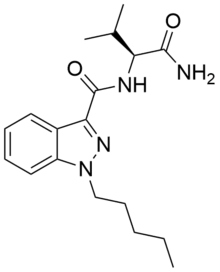AB-PINACA
AB-PINACA is a compound that was first identified as a component of synthetic cannabis products in Japan in 2012.[1]
 | |
| Legal status | |
|---|---|
| Legal status |
|
| Identifiers | |
IUPAC name
| |
| CAS Number | |
| PubChem CID | |
| ChemSpider | |
| UNII | |
| Chemical and physical data | |
| Formula | C18H26N4O2 |
| Molar mass | 330.432 g·mol−1 |
| 3D model (JSmol) | |
SMILES
| |
InChI
| |
It was originally developed by Pfizer in 2009 as an analgesic medication.[2][3]
AB-PINACA acts as a potent agonist for the CB1 receptor (Ki = 2.87 nM, EC50 = 1.2 nM) and CB2 receptor (Ki = 0.88 nM, EC50 = 2.5 nM) and fully substitutes for Δ9-THC in rat discrimination studies, while being 1.5x more potent.[4][5]
There have been a number of reported cases of deaths and hospitalizations in relation to this synthetic cannabinoid.[6]
Legal status
Germany
AB-PINACA is an Anlage II controlled substance in Germany as of November 2014.[7]
Singapore
It is listed in the Fifth Schedule of the Misuse of Drugs Act and so is illegal in Singapore, as of May 2015.[8]
United Status
It is a Schedule I controlled substance in the United States.[9]
China
It is a controlled substance in China as of October 2015.[10]
France
It is a controlled substance in France as of March 2017.[11]
See also
References
- Uchiyama, N.; Matsuda, S.; Wakana, D.; Kikura-Hanajiri, R.; Goda, Y. (2012). "New cannabimimetic indazole derivatives, N-(1-amino-3-methyl-1-oxobutan-2-yl)-1-pentyl-1H-indazole-3-carboxamide (AB-PINACA) and N-(1-amino-3-methyl-1-oxobutan-2-yl)-1-(4-fluorobenzyl)-1H-indazole-3-carboxamide (AB-FUBINACA) identified as designer drugs in illegal products". Forensic Toxicology. 31: 93–100. doi:10.1007/s11419-012-0171-4.
- "AB-PINACA". Cayman Chemical. Retrieved 25 June 2015.
- "Patent WO/2009/106980 - Indazole derivatives". Cite journal requires
|journal=(help) - Banister, Samuel D.; Moir, Michael; Stuart, Jordyn; Kevin, Richard C.; Wood, Katie E.; Longworth, Mitchell; Wilkinson, Shane M.; Beinat, Corinne; Buchanan, Alexandra S.; Glass, Michelle; Connor, Mark; McGregor, Iain S.; Kassiou, Michael (2015). "Pharmacology of Indole and Indazole Synthetic Cannabinoid Designer Drugs AB-FUBINACA, ADB-FUBINACA, AB-PINACA, ADB-PINACA, 5F-AB-PINACA, 5F-ADB-PINACA, ADBICA, and 5F-ADBICA". ACS Chemical Neuroscience. 6 (9): 1546–59. doi:10.1021/acschemneuro.5b00112. PMID 26134475.
- Jenny L Wiley; Julie A Marusich; Timothy W Lefever; Kateland R Antonazzo; Michael T Wallgren; Ricardo A Cortes; Purvi R Patel; Megan Grabenauer; Katherine N Moore; Brian F Thomas (June 2015). "AB-CHMINACA, AB-PINACA, and FUBIMINA: Affinity and Potency of Novel Synthetic Cannabinoids in Producing Δ9-Tetrahydrocannabinol-Like Effects in Mice". Journal of Pharmacology and Experimental Therapeutics. 354 (3): 328–39. doi:10.1124/jpet.115.225326. PMC 4538877. PMID 26105953.
- Jordan Trecki; Roy R. Gerona; Michael D. Schwartz (July 2015). "Synthetic Cannabinoid–Related Illnesses and Deaths". New England Journal of Medicine. 373 (2): 103–107. doi:10.1056/NEJMp1505328. PMID 26154784.
- "Gesetz über den Verkehr mit Betäubungsmitteln (Betäubungsmittelgesetz - BtMG) Anlage II (zu § 1 Abs. 1) (verkehrsfähige, aber nicht verschreibungsfähige Betäubungsmittel)". Retrieved 22 June 2015.
- "CNB NEWS RELEASE". Central Narcotics Bureau (CNB). 30 April 2015. Archived from the original on 15 July 2015. Retrieved 24 July 2015.
- "Schedules of controlled substances: Temporary placement of three synthetic cannabinoids into schedule I. Final order" (PDF). Drug Enforcement Administration, Department of Justice. 30 January 2015. Retrieved 9 July 2015.
- "关于印发《非药用类麻醉药品和精神药品列管办法》的通知" (in Chinese). China Food and Drug Administration. 27 September 2015. Retrieved 1 October 2015.
- "Arrêté du 31 mars 2017 modifiant l'arrêté du 22 février 1990 fixant la liste des substances classées comme stupéfiants" (in French). Legifrance. 6 April 2017. Retrieved 6 April 2017.